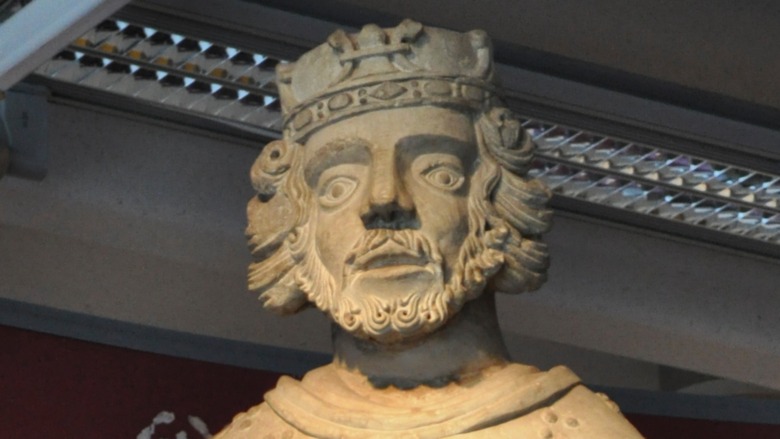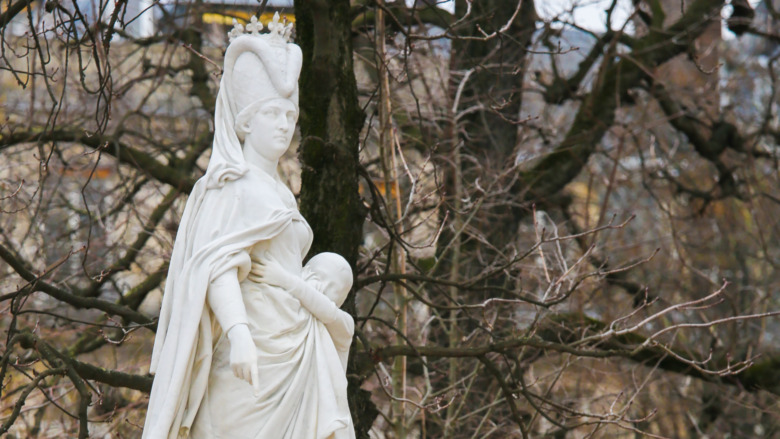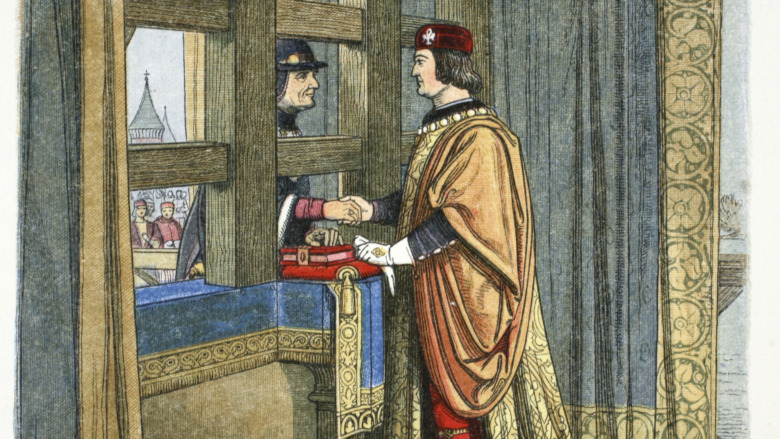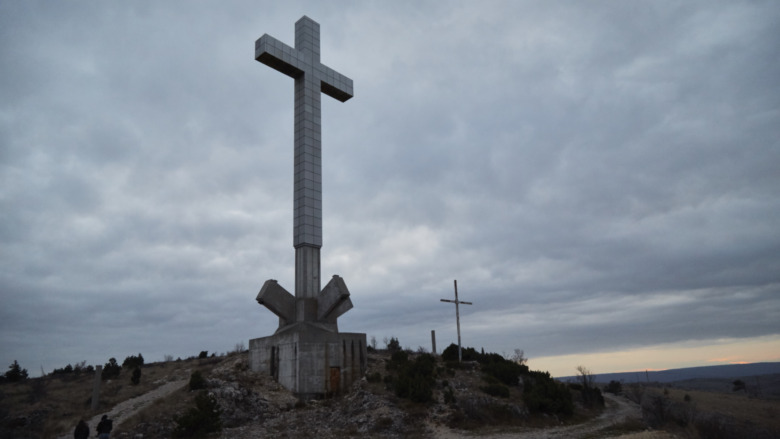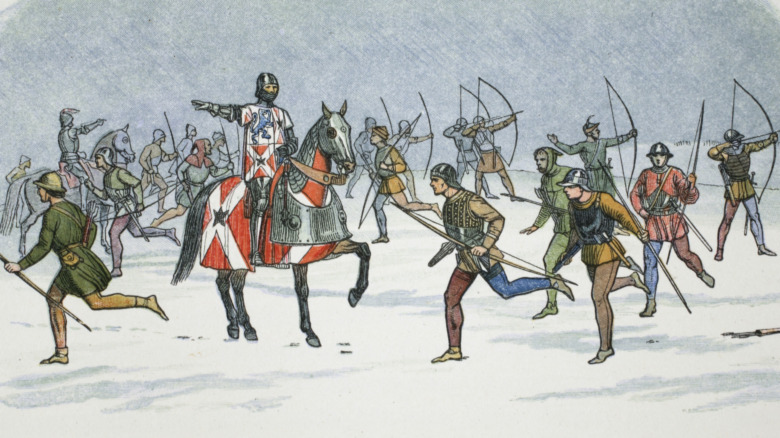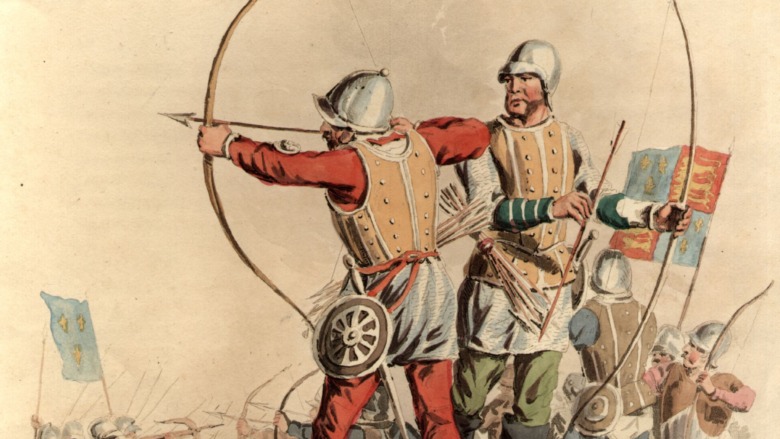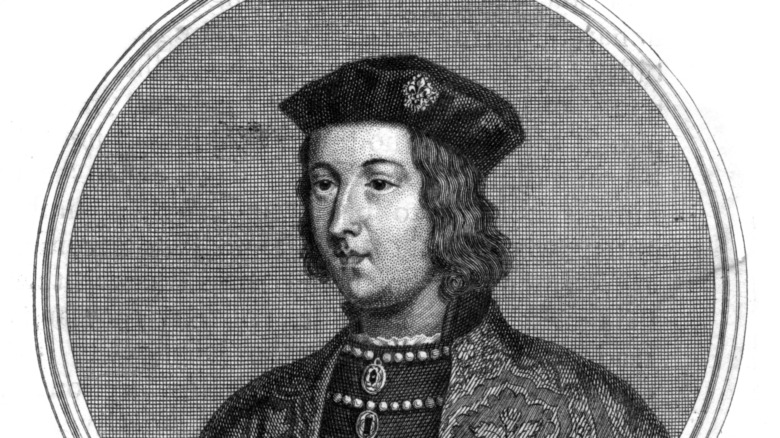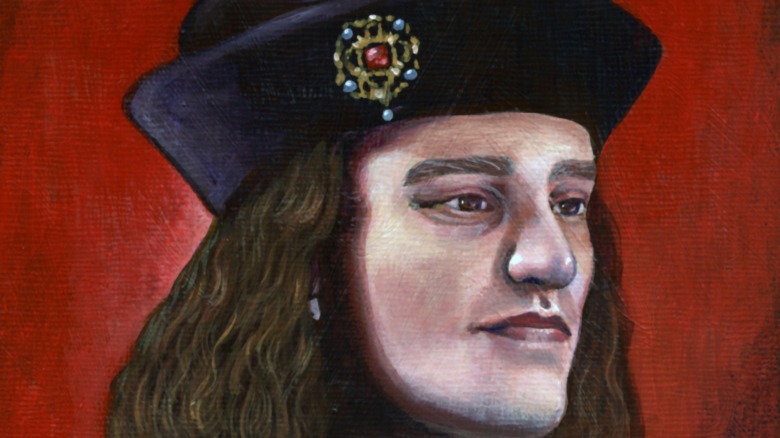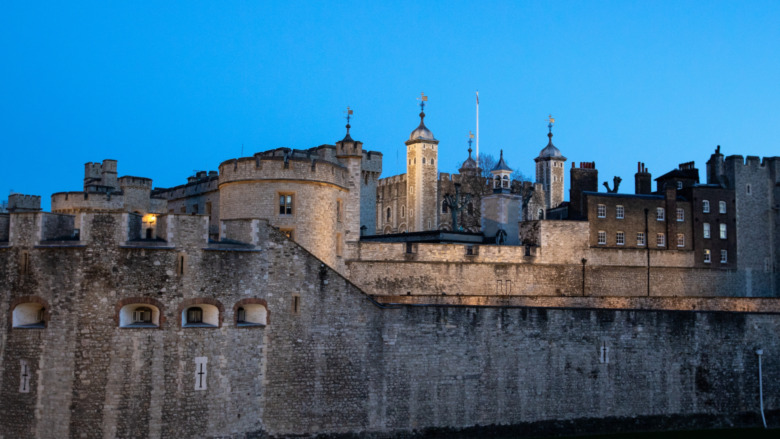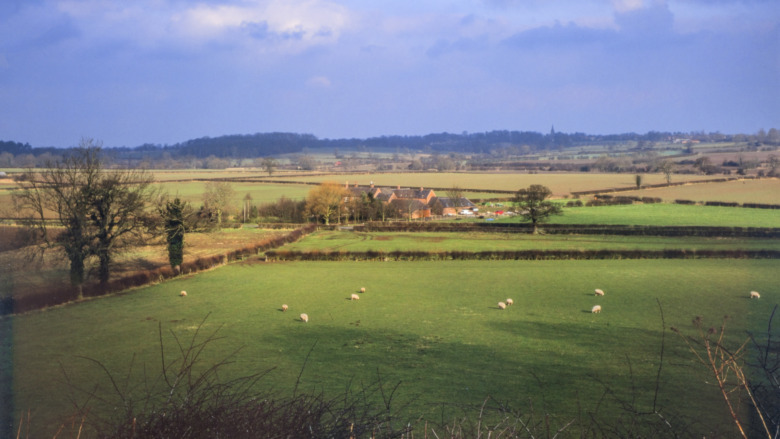What It Was Really Like Being In The Wars Of The Roses
The Wars of the Roses. You know, what influenced George R. R. Martin while writing "Game of Thrones"? Or, alternatively, what England was like before Henry VIII and his six wives? The Wars of the Roses were a three-decades-long fight between several branches of one family (Yorks, Lancasters, and Tudors) over who should sit on England's throne.
The first few years of the wars started out small, only involving 2,000 to 3,000 soldiers. Since those soldiers were privately employed, most of the common people were likely barely aware of them. According to History Today, due to the Tudor dynasty's emphasis on sharing their view of what happened, it has been difficult for historians to find motives for everyone else involved.
Since no records were conclusive, it's unknown just how many people were involved over the course of 30 years, writes History Today. However, records of battles seem to indicate that armies grew as the wars wore on. The longer the conflict went on without a definite resolution, the more people got involved. The Battle of Towton probably involved around somewhere between 50,000 and 75,000 soldiers. Early on, battles were fought on the edges of controlled territory, and local soldiers were called out to fight, therefore making up most of the rapidly growing armies.
Therefore, soldiers' families indirectly got involved. If a husband and son, or several sons, were out fighting on behalf of the local lord or would-be king, wives and daughters kept the home fires burning and prayed for their safe return.
Long on time, short on fighting
The Wars of the Roses lasted for over 30 years, says History. However, there was plenty of downtime as battles were fought over months as opposed to years. However, every army that came through England, growing as it went, left a trail of devastation that took time to fix, according to History Today. Queen Margaret of Anjou's army, marching toward the Battle of St. Albans, left destruction that was supposedly 30 miles wide. Her additions of Scottish and French mercenaries were blamed, considering the queen's hated French ancestry.
The wars started with the commoners wanting change, as the Lancastrian Henry VI was an incompetent, weak king. Commoner Jack Cade led several rebellions, and people joined the Yorkists' cause mainly because it would be a different form of leadership, writes History Today. At some point, though, it had to seem excessive as the battles went on and soldiers were called up again and again.
Britain knew war beforehand
Prior to the beginning of the Wars of the Roses, the Hundred Years' War with France had been ongoing for the past century, which meant the British were already familiar with war. In fact, the Hundred Years' War wasn't even fully settled until 1475, by Edward IV and Louis XI, writes Britannica. France and Britain had always been enemies, and in a way, the Hundred Years' War was incredibly similar to the Wars of the Roses. The English believed that their king should also sit on the throne of France.
Soldiers devastated the farmland in both countries, mercenaries in France especially, according to Lumen Learning. France's population dropped by half by the time the Hundred Years' War was done. Local, feudal armies phased out over the course of the century, and professional armies mainly made up of commoners became the norm. English nobles who lost land in France became restless, which would kick off the Wars of the Roses.
Ultimately, the war came to a close mainly because the French soldiers were too strong, writes History. But a mentality was set because, for decades, English soldiers were used to going off to war, so the longevity of the Wars of the Roses must not have seemed like much of a surprise. Plus, the fight did not extend to other countries, so the soldiers knew they would stay in England.
Signs and superstition were rampant
Towards the beginning of the Wars of the Roses, the Yorks felt they would be successful because of the so-called "three suns of York." During one of the first major battles of the wars, the Battle of Mortimer's Cross in 1461, everyone there witnessed what appeared to be three suns rising in the sky. Though most were instantly wary, Edward IV claimed it was a good omen, writes British Heritage. The three suns were representative, Edward IV felt, of himself and his two brothers.
The Lancastrians were unlucky due to their foreign mercenaries taking more time to arrive to the battlefield. Almost 4,000 soldiers died that day, according to British Heritage. The battle lasted all morning and most of an afternoon. Soldiers drowned trying to swim the nearby river or were killed by opponents lying in wait (via British Heritage). Ultimately, the victory was for York and Edward IV, crowned only four months later. The new king ended up incorporating the sun into his badge (via Decoded Science).
Decades later, on March 16, 1485, England experienced a solar eclipse, according to Science Daily. Many saw it as God turning his favor from King Richard III, which did happen months later at Bosworth. Everyone in England was Catholic and therefore naturally saw signs and portents everywhere.
Soldiers participated in one of the bloodiest battles in British history
Though the actual fighting during the Wars of the Roses was slim, the Battle of Towton was the bloodiest one-day battle Britain has experienced. Approximately 50,000 soldiers fought, with about 28,000 dying, according to History.
Between 50,000 to 65,000 soldiers met each other on a field near Towton and Saxton on a snowy Palm Sunday of 1461, according to Historic UK. Edward IV was 18 and ready to follow in his father's footsteps in dethroning the current Lancastrian king, Henry VI. The two armies fought hard for most of the day, around 10 hours, neither gaining ground (via History Today). Eventually, however, the Lancastrian troops folded. Many soldiers were killed even as they fled the field.
According to the bill of attainder drawn up after Towton, it's clear that most of the commoners who fought came from the north, though some came from farther away, such as Hertfordshire (via History Today). The graves around Towton show just how many men died at fairly young ages. The wars wrecked havoc for decades to come, just based on how many Englishmen died in early adulthood. Since the wars went on for decades, a soldier could see his son go off to fight in another battle against the same enemy he'd fought himself years before.
There were no major battles for three years due to just how many men had died at Towton, writes Historic UK. Henry VI, Queen Margaret, and their son had all fled to Scotland, meaning the strife would continue.
Edward IV fled England for a while
Edward IV, sat the throne until October 1470, when he fled to Burgundy after the opposition invaded. The crown was thus restored to Henry VI. Though Edward had been king for nearly a decade, his popularity among the common people had fallen, according to Charles Ross' "Edward IV." The scholar John Warkworth recorded that the people were glad for a change at the beginning of the decade, but the prosperity they hoped for didn't come to pass. With war continuing, soldiers still needed to serve. There were also complaints of increasing taxes.
Not sitting around, Edward IV gathered a trusted band of friends and returned to England to win victories in the battles of Barnet and Tewksbury, says History, subsequently regaining the throne and ruling until 1483.
No one knew who to support
Several betrayals happened on the battlefield, drastically changing the outcome of the wars. There were no treaties or compromises made throughout the wars, as this was a dynastic fight. According to World History, the point of these battles was to obliterate the other side and emerge permanently victorious.
The Earl of Warwick supported the Yorks at first, particularly Edward IV, and eventually gained the nickname "the Kingmaker" for helping to put him on the throne during the first half of the wars (via Britannica). However, in 1470, Warwick joined the Lancaster opposition in a shocking betrayal to put Henry VI back on the throne. Warwick was killed during the resulting Battle of Barnet, ensuring Edward IV's ultimate victory (via Historic UK).
Lord Thomas Stanley was notable for playing "both sides at once," says History Times History. He would "seamlessly slip between support for the Lancastrian cause and the Yorkist cause, and then found that he could just as happily embrace the new Tudor monarchy," as long as he got his just rewards.
Decades later, Stanley's two sons were on opposite sides at the Battle of Bosworth Field, ensuring that whoever won would still hold the family in favor. On hearing that one of his sons would be executed (this did not come to pass), Stanley reportedly told king-of-the-moment, Richard III, "Sire, I have other sons" (writes History Times History).
Kings were harsh
In an age when executions were common, rulers were harsh. Even rulers who are considered popular or enlightened now, such as Elizabeth I, executed some of their subjects. Wars were fought constantly, and children died at all manner of ages. Punishments reflected the difficulties of life.
Nobles were executed over the course of the wars. According to World History, brutality and assassinations increased for political reasons. Henry VI may have been smothered in the Tower of London in order to prevent his returning to the throne. The wars meant total annihilation of the enemy, and many commanders took that to heart.
Tensions can be heightened during wartime, and considering the Wars of the Roses went on for 30 years, it's not much of a surprise that nobles were high-strung and wanted to be sure they stayed on the right side of the monarch of the moment.
Common soldiers or soldiers in private armies were inadvertently dragged into battles their lords were participating in. Many battles, writes World History, were small, only involving 100 casualties, but others were bloodbaths like Towton. Commanders and common soldiers alike had no way of knowing which kind of fight they were getting into until it was already underway.
Chaos and mysteries abounded
Many nobles either died in battle or were executed during the Wars of the Roses. Others, not watched as closely amid the chaos, began to use their private armies for their own use. News traveled slowly, and it was presumably unclear which rulers would care what nobles did to settle issues. For example, the Battle of Nibley Green was fought to settle disputes between the Lisle and Berkeley families (via North Nibley). It was the last battle in England between fairly small private armies.
When a king took the throne back, the opposer's family either fled for their lives, or in the case of Yorkist queen, Elizabeth Woodville, went into sanctuary. In 1470, when her husband, King Edward IV, fled England, Elizabeth and her children sought asylum at Westminster Abbey (via Westminster Abbey). This meant that she and her children, as important politicians, were given immunity from suddenly being killed. Since she hoped that her husband would return victorious, sanctuary allowed her to stay in England, and stay safe, among all the commotion of the throne changing hands again.
After Edward IV died, his younger brother Richard III seized power and had his nephews, Edward V and Richard, lodged in the Tower of London. They disappeared scant weeks afterwards, in June 1483, according to Britannica. Their disappearance has been an enduring mystery for centuries. According to Historic Royal Palaces, stories were told of two ghosts thought to be the princes. There were several pretenders to the throne who claimed to be one of the princes in Henry VII's early reign.
Leaders won and lost -- constantly
Henry VI, Edward IV, and Richard III were all in and out of power several times over the course of the wars. The eventual-Henry VII won out at the Battle of Bosworth Field, a culminating battle in the wars, against Richard III, says Britannica.
The 15th century was still the period of divine right, or God granting the monarch's family right to reign. However, as World History notes, the Wars of the Roses made it easier to convince commoners and lords that divine right also relied on a king's strength to claim the throne and keep it. Therefore, if they were also the descendant of a king, they had God's given right to rule.
Even if English commoners supported Richard III, they were quick to change their tune once Henry VII was crowned. Henry VII killing off his opponents didn't help. Nobles did the same, though the end of the wars also saw Henry VII's domination over those remaining. Around half of the nobility were wiped out over the course of the 30-year-long civil war, according to World History.
A decisive victory at Bosworth
Prior to the Battle of Bosworth Field, the Tudors were not seen as likely candidates for the throne, writes Britannica. However, Henry Tudor became a key player thanks to his mother's marriages throughout his childhood – she married Thomas Stanley in 1472, and he ultimately was the lynchpin in Tudor's victory over the throne — and later the deaths of his kinsmen, making him "the sole surviving male with any ancestral claim to the house of Lancaster."
The final battle of the Wars of the Roses, at Bosworth Field, took place on August 22, 1485. Since Henry Tudor had sailed from France to Wales, and from there had gone to Leicestershire, his army grew as he traveled, to around 5,000 men (via Historic UK). His stepfather, Thomas Stanley, also brought his own private army of 6,000 men to the battle, and he watched and waited until the outcome was clear before joining his stepson's side. Henry's decision to marry Elizabeth of York also convinced those who liked the Yorkists, but not Richard III, to support him and strengthened his own shaky claim.
The Tudor army was outnumbered roughly two to one. Around 15,000 soldiers were on the field throughout, according to Historic UK. After some back and forth, Richard III made a charge for his opponent. He was killed and Henry VII was crowned on the battlefield.
Henry VII held onto his throne throughout the years after Bosworth, killing his opponents. Therefore, he proved to the people he had the right to rule, and the Tudor dynasty began, thus ending the wars.
Afterwards, there was more work to do
Henry VII served as a stable hand for England, turning away pretenders to the throne and securing his dynasty. The Wars of the Roses definitively ended with the Battle of Stoke Field in 1487, according to Historic UK, when pretender-to-the-throne Lambert Simnel was captured and pardoned.
Henry VII is best known now as a miser, though he was also very politically savvy. Trade flourished during his reign, as he signed treaties with Denmark, Spain, Portugal, Florence, and the Netherlands (via World History Encyclopedia).
With every generation, politics and social life changed, and that wasn't felt more than during the Wars of the Roses. Nobles were firmly under Henry VII's control, much easier now that the number of English noble families had been divided in half (via World History). Commoners were also able to relax somewhat since Henry VII had no intention of losing his throne to another. Common soldiers weren't called out to fight their countrymen as they had been in decades past.
